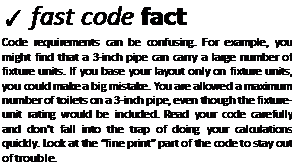DRAIN-AND-SEWER CALCULATIONS
|
D |
oing calculations for drains and sewers is similar, in principle, to what you will use for vents in the next chapter. The process involves fixture units, the developed length of piping, sizing tables, and so forth. Paying attention to details is an important element in designing any type of system, and this certainly holds true when sizing drains and sewers. Moving too quickly and using the wrong sizing table can cause you a lot of trouble. When work is simplified, it sometimes seems so simple that it is taken too lightly. Don’t make mistakes by not paying attention to footnotes and exclusions when you use sizing tables. If you read the tables carefully and apply them properly, sizing is not difficult.
 Some plumbers get so accustomed to using sizing tables that they fail to think of code requirements that may make the tables inaccurate if all notes are not observed and followed. For example, let’s say that you are sizing a sewer for a home.
Some plumbers get so accustomed to using sizing tables that they fail to think of code requirements that may make the tables inaccurate if all notes are not observed and followed. For example, let’s say that you are sizing a sewer for a home.
You might do your homework and find that the total number of fixture units is low enough that a 3-inch sewer can be used. This might be the case, but you could be setting yourself up for trouble.
Accuracy in sizing pipes is essential to a job in more than one way. First, you have to draw riser diagrams and size the pipes for code approval. And, you need accurate sizing to price a job for bidding purposes.
Let’s say that you did believe that a home could get by with a 3-inch sewer. Assume that the home was a townhouse and that it was one of 300 in a project, where you were bidding the entire project. This means that you basically figure maybe four styles of houses
49
and then apply the information to the entire project. The cost difference between 3-inch and 4-inch pipe doesn’t seem like a lot when you are dealing with short runs. But, when you are dealing with 300 runs, even small differences in cost can add up quickly. So, what would happen if you figured a job for 3-inch sewers and wound up having to install 4-inch sewers? You or your employer would lose money, possibly a substantial sum.
![]()
![]()
 When we get further into this chapter you will see actual examples of how a mistake might be made when using sizing tables for drains and sewers. But, I’d like to point out a quick one now, so that you will keep your eyes open when we get to the sizing tables. okay, it is very likely that the total fixture load for a 3- bathroom townhouse would be low enough to allow the use of a 3-inch sewer. if you were in a hurry, did a quick calculation of fixture units and scanned a sizing table, you might jump right at using 3-inch pipe to keep costs down. This would be a mistake. Why? Because even though a 3-inch pipe could handle the fixture units, most codes limit a 3-inch pipe to serving no more than two water closets in close proximity. If the townhouse has three toilets, a 4-inch sewer is likely to be needed.
When we get further into this chapter you will see actual examples of how a mistake might be made when using sizing tables for drains and sewers. But, I’d like to point out a quick one now, so that you will keep your eyes open when we get to the sizing tables. okay, it is very likely that the total fixture load for a 3- bathroom townhouse would be low enough to allow the use of a 3-inch sewer. if you were in a hurry, did a quick calculation of fixture units and scanned a sizing table, you might jump right at using 3-inch pipe to keep costs down. This would be a mistake. Why? Because even though a 3-inch pipe could handle the fixture units, most codes limit a 3-inch pipe to serving no more than two water closets in close proximity. If the townhouse has three toilets, a 4-inch sewer is likely to be needed.
As a teacher of plumbing courses, I’ve seen a number of experienced plumbers fall for this trap on some of the tests that I’ve created. The plumbers get into a rhythm and fail to think or to see the notes on the sizing charts and distance requirements. It’s bad to miss a question on an exam, but it would be much worse to make the mistake in the real world of plumbing. By catching the plumbers in the classroom, I hope to make them aware of the crossover traps that can be embedded in the plumbing code. There are usually exceptions, options, and exclusions that can change the meaning of the code in certain situations. The 3-inch sewer is one excellent example of such pitfalls. You do have to pay attention to what you are doing when sizing systems.
There are several types of sanitary drains. A building sewer is usually considered to be the main drain for a building that starts outside of the building and
 extends to a municipal sewer or private sewage-disposal system. Building drains are the primary drains inside of a building. Then there are branch intervals, horizontal branches, vertical stacks, and so forth. When you begin sizing a drainage system, you must make sure that you are using the proper sizing procedures for the type of drain or sewer that you are working with.
extends to a municipal sewer or private sewage-disposal system. Building drains are the primary drains inside of a building. Then there are branch intervals, horizontal branches, vertical stacks, and so forth. When you begin sizing a drainage system, you must make sure that you are using the proper sizing procedures for the type of drain or sewer that you are working with.
All types of drains and sewers can be calculated with a method that depends on the ratings of drainage fixture units.
![]()

 Fixture-unit ratings are established by local codes. A probability factor is built into the system. While a direct flow rate or discharge rate cannot be determined from the rating of fixture units, the fixture units are accurate enough to allow a sensible system to be designed in compliance with the plumbing code.
Fixture-unit ratings are established by local codes. A probability factor is built into the system. While a direct flow rate or discharge rate cannot be determined from the rating of fixture units, the fixture units are accurate enough to allow a sensible system to be designed in compliance with the plumbing code.






Leave a reply